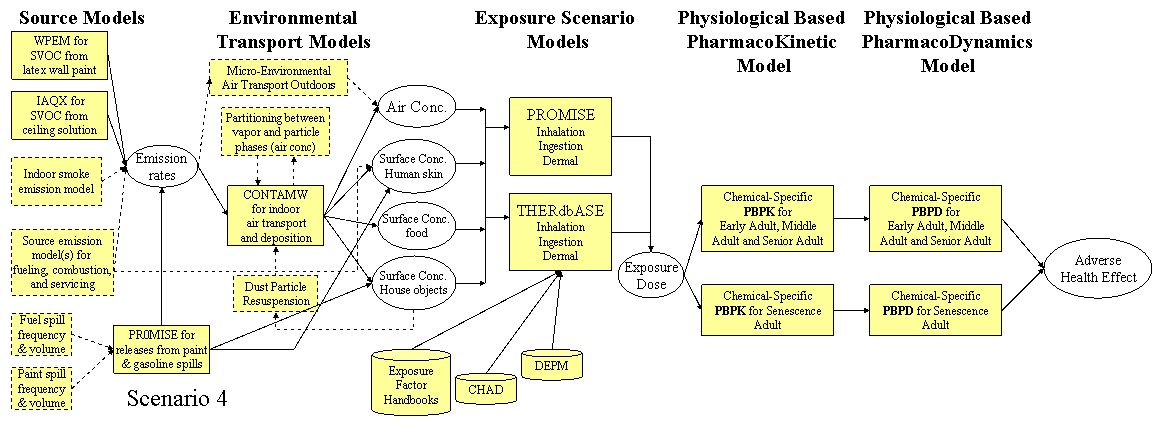
![]() 4.0 Scenarios
4.0 Scenarios
4.1 Life Stages
4.2 Scenario 1
Model Flow Diagram 1
4.3 Scenario 2
Model Flow Diagram 2
4.4 Scenario 3
Model Flow Diagram 3
4.5 Scenario 4
Model Flow Diagram 4
4.6 Process Flow
4.7 Gap Analysis

| Diagram Legend | |
|---|---|
| Solid boxes | Models with known codes available |
| Dashed boxes | Models with codes not available |
| Ovals | Input/output files with specific data specifications |
| Cylinders | Model-Specific databases |
| Arrows | Indicates the flow of the data |
| PBPK | Physiologically-based Pharmacokinetics |
| PBPD | Physiologically-based Pharmacodynamics |
- WPEM was developed for latex or alkyd paint.
- IAQX can be used for the solution on wood ceiling strips, since it is for emissions from building materials, including dry sources.
- One possible source of models to use for mainstream smoking is from the external review article http://ehpnet1.niehs.nih.gov/docs/1999/Suppl-2/375-381ott/abstract.html for smoking release.
- Indoor air transport modeling (VOC emission) can be handled by many models, we selected CONTAM for this case, because it can handle aerosols, but at least 4 other models identified in the literature review could be used. Some of the transport models are planning to add VOC, aerosol, and particle deposition components and in some cases separate models could handle deposition to product surface concentrations.
- PROMISE and THERdbASE are used to estimate human activity patterns and exposure doses. We would prefer to use LifeLine, Cares and other multi-route, multi-source models but it is difficult to integrate them because they proprietary and much of the needed information is not readily available.
- DEPM includes information on food intake for estimating dietary exposure
- CHAD is a master database that provides information on human activity
- EPAís Exposure Factors Handbook for adults will be used accordingly.
- Note that there is a PBPK or PBPD model for each of the three chemicals of concern developed specifically for an adult male.
- Data gap: There are no current models incorporating the effects of cigarette smoking on PBPK model parameters.
- It should also be noted that interactions and competing causes of action can also be incorporated in the PBPK and Mode of Action models depending on available information
- LifeLine, CARES, and other lifestyle aggregate codes will overlay onto the PBPK and Mode of Action models.
